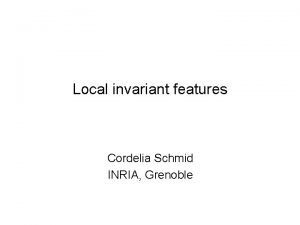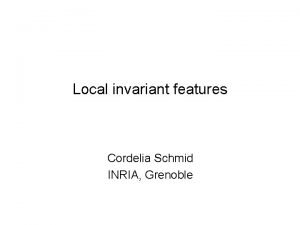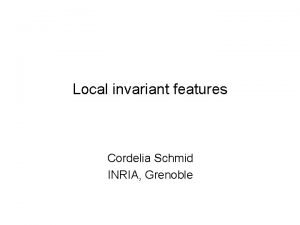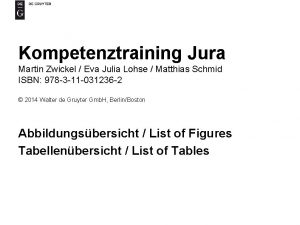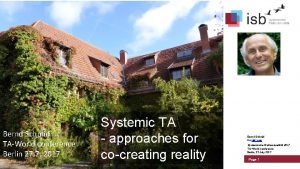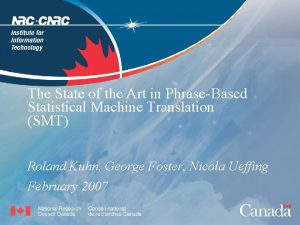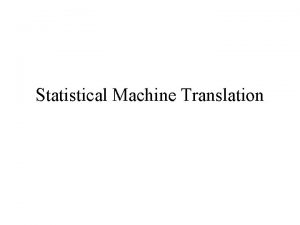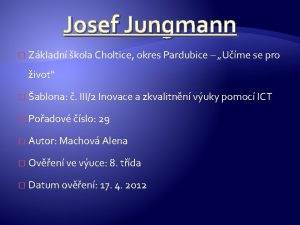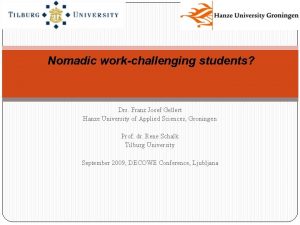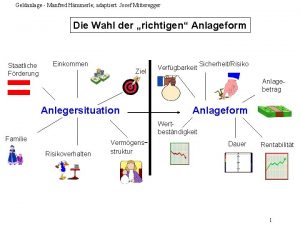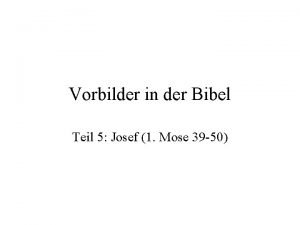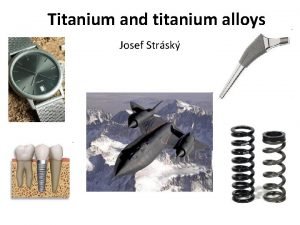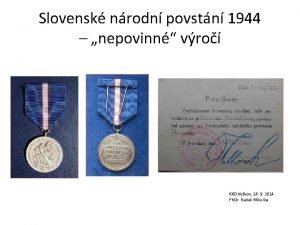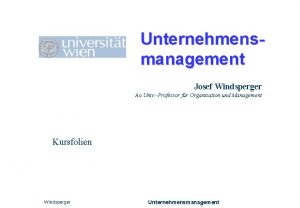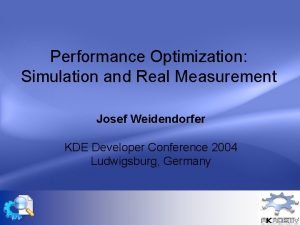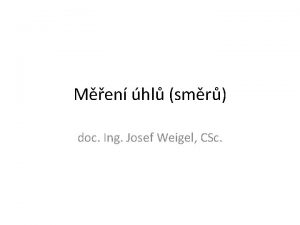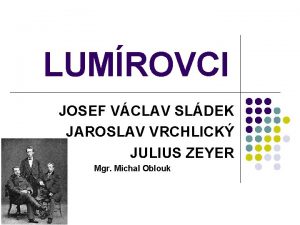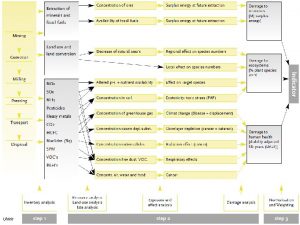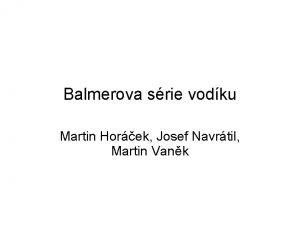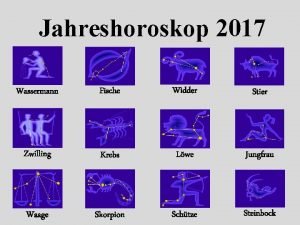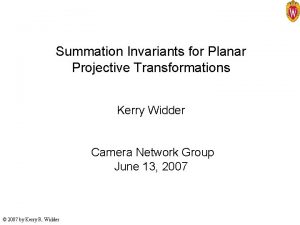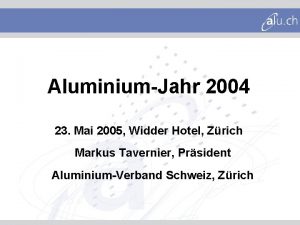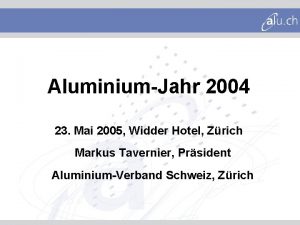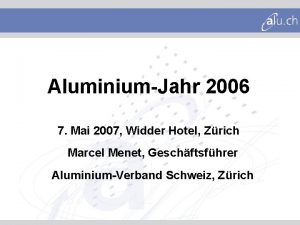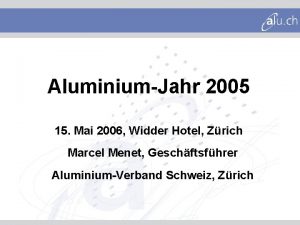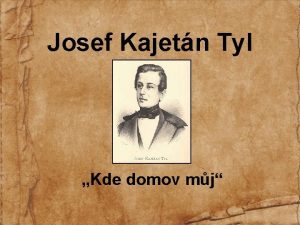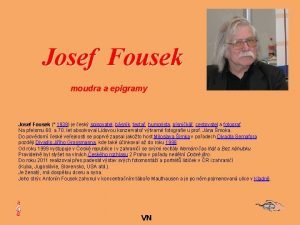The Model Ulrich Schmid Josef Widder Martin Hutle






![But still … Hermant & Le Lann [HLL 02]: τ+ = γ(n) with (Note But still … Hermant & Le Lann [HLL 02]: τ+ = γ(n) with (Note](https://slidetodoc.com/presentation_image_h/293840ecf136a2aa02c2b257609fbcff/image-7.jpg)



![The FLP Asynchronous Model (I) • Fischer, Lynch & Paterson [FLP 85] • System The FLP Asynchronous Model (I) • Fischer, Lynch & Paterson [FLP 85] • System](https://slidetodoc.com/presentation_image_h/293840ecf136a2aa02c2b257609fbcff/image-11.jpg)



![Partially Synchronous Models (I) • Dwork, Lynch & Stockmeyer [DLS 88], Ponzio & Strong Partially Synchronous Models (I) • Dwork, Lynch & Stockmeyer [DLS 88], Ponzio & Strong](https://slidetodoc.com/presentation_image_h/293840ecf136a2aa02c2b257609fbcff/image-15.jpg)
![Partially Synchronous Models (II) • Archimedean model by Vitany [Vit 85] – Bounded ratio Partially Synchronous Models (II) • Archimedean model by Vitany [Vit 85] – Bounded ratio](https://slidetodoc.com/presentation_image_h/293840ecf136a2aa02c2b257609fbcff/image-16.jpg)



![But … • There is the ([DLS 88]: hidden, [Vit 85]: explicit) assumption that But … • There is the ([DLS 88]: hidden, [Vit 85]: explicit) assumption that](https://slidetodoc.com/presentation_image_h/293840ecf136a2aa02c2b257609fbcff/image-20.jpg)










![Partial Order of Partially Synchronous Models • DLS … [DLS 88] with a priori Partial Order of Partially Synchronous Models • DLS … [DLS 88] with a priori](https://slidetodoc.com/presentation_image_h/293840ecf136a2aa02c2b257609fbcff/image-31.jpg)
![Existing Θ-Algorithms • Perfect failure detectors [Schmid and Le Lann 2003] • Clock synchronization Existing Θ-Algorithms • Perfect failure detectors [Schmid and Le Lann 2003] • Clock synchronization](https://slidetodoc.com/presentation_image_h/293840ecf136a2aa02c2b257609fbcff/image-32.jpg)



![Evaluation Setup • Master thesis by Daniel Albeseder [Alb 04] • Pentium 4 workstations Evaluation Setup • Master thesis by Daniel Albeseder [Alb 04] • Pentium 4 workstations](https://slidetodoc.com/presentation_image_h/293840ecf136a2aa02c2b257609fbcff/image-36.jpg)















- Slides: 51

The Θ-Model Ulrich Schmid Josef Widder Martin Hutle Daniel Albeseder Vienna University of Technology Embedded Computing Systems Group http: //www. ecs. tuwien. ac. at 3/6/2021 Gérard Le Lann Jean-François Hermant INRIA Rocquencourt Project Novaltis http: //www. inria. fr Theta-Model (Version 1. 3) 1

Motivation Theta-Model 2

Timed Algorithms • Most FT algorithms for distributed RTS have explicit time values (unit „seconds“) in their code / variables • Toy example: Local real-time clock for timing out a crashed process msg_pong = do_roundtrip(msg_ping, p) send msg_ping to p TIMEOUT : = C(t) + 2τ+ /* max. e. -t. -e. delay τ+ (sec) */ while C(t) < TIMEOUT do nothing if msg_pong did not arrive then msg_pong : = NIL return msg_pong Theta-Model 3

Implications ? • Safety properties like consistency of replicated data may depend upon non-NIL operation of do_roundtrip • Usual assumption: Real-time systems must always meet their timeliness properties ðOnly possible if all end-to-end delays δ ≤ τ+ ðSafety properties also guaranteed in this case • BUT: Bounds like τ+ that always hold are very difficult to determine for real systems • Fail-operational systems might be allowed to sometimes lose timeliness – but never lose consistency Theta-Model 4

Why is determining τ+ difficult ? • Queuing phenomenons: – Simultaneous messages from different peers (CPU) – Multiple processes (CPU) – Multiple messages (Link) • End-to-end delays hence depend upon – message & computational complexity of algorithms – interaction („blocking factors“) – load conditions – scheduling disciplines Theta-Model 5

Importance of Scheduling ? • τ+ can be huge in real systems since all messages [including application-level] must be taken into account – Maximum determines synchronous round duration too conservative for most messages – Escape: Appropriate scheduling • Fast Failure Detectors by Hermant & Le Lann [HLL 02] – Use Head-of-the-Line Scheduling for FD-level processes and messages – Only blocking factors due to non-preemptible resources can lead to priority inversion phenomenons on FD-level ðτ+ relevant for failure detection latency reduced by orders of magnitude Theta-Model 6
![But still Hermant Le Lann HLL 02 τ γn with Note But still … Hermant & Le Lann [HLL 02]: τ+ = γ(n) with (Note](https://slidetodoc.com/presentation_image_h/293840ecf136a2aa02c2b257609fbcff/image-7.jpg)
But still … Hermant & Le Lann [HLL 02]: τ+ = γ(n) with (Note that wout. Q, woutq and winq are the problematic parts here) • Do you trust a real system to always obey this, during the whole mission time? • Do you really want your safety and liveness properties to depend on this? Theta-Model 7

Alternatives ? Ø Are there ways to guarantee logical safety & liveness properties independently of the timing properties of the underlying system ? YES: Asynchronous algorithms (time-free, message-driven) Ø Are there suitable time-free computational models and algorithms ? YES: Θ-Model Theta-Model 8

Roadmap of our Presentation Overview of Computational Models ₪ The Θ-Model ₪ First Experimental Results ₪ Applications Theta-Model 9

Overview of Computational Models Theta-Model 10
![The FLP Asynchronous Model I Fischer Lynch Paterson FLP 85 System The FLP Asynchronous Model (I) • Fischer, Lynch & Paterson [FLP 85] • System](https://slidetodoc.com/presentation_image_h/293840ecf136a2aa02c2b257609fbcff/image-11.jpg)
The FLP Asynchronous Model (I) • Fischer, Lynch & Paterson [FLP 85] • System of n processes communicating via reliable point -to-point network – Every message sent is eventually delivered – No bounded-drift clocks available • Computational step times are non-negative, finite but unbounded (i. e. , can exceed any a priori given bound) • Message transmission delays are non-negative, finite but unbounded Theta-Model 11

The FLP Asynchronous Model (II) • FLP model has no timing assumption at all cannot be violated at runtime • BUT: In the FLP-Model, it is impossible to distinguish a slow from a crashed process ð Important DC problems like consensus impossible to solve in the FLP-Model in the presence of failures ð For solvability, some property/properties must be added to the pure FLP model. Theta-Model 12

The FLP Asynchronous Model (III) • Resulting spectrum of models: FLP partially synchronous • Clearly: The stronger the added property the less is the assumption coverage in real systems • Usually: Add explicit timeliness properties to the FLPModel • Sometimes: Add implicit timeliness properties to the FLP-Model (time-free models) Theta-Model 13

(Close to) Synchronous Models • Synchronous model allows simulation of lock-step rounds – Transmission delay bound Δ – Computing step time bound σ – Bounded-drift local clocks available • Timed Asynchronous Model by Cristian & Fetzer [CF 99] – – Transmission delay bound Δ Computing step time bound σ Bounded-drift local clocks available BUT: Fail awareness allows bounds Δ and σ to be violated arbitrarily often fail-safe behavior Theta-Model 14
![Partially Synchronous Models I Dwork Lynch Stockmeyer DLS 88 Ponzio Strong Partially Synchronous Models (I) • Dwork, Lynch & Stockmeyer [DLS 88], Ponzio & Strong](https://slidetodoc.com/presentation_image_h/293840ecf136a2aa02c2b257609fbcff/image-15.jpg)
Partially Synchronous Models (I) • Dwork, Lynch & Stockmeyer [DLS 88], Ponzio & Strong [PS 92], Attiya, Dwork, Lynch & Stockmeyer [ADLS 94] – Transmission delay bound Δ – Bounded ratio of max. over min. computing step times Φ – Bounds unknown / known but hold from unknown time GST on • Every process can locally time-out messages: – [PS 91, ADLS 94]: Semi-synchonous model assumes availability of bounded-drift local clocks – [DLS 88]: Computing steps of fastest processor are used as realtime units [= unit of Δ !] local clock with bounded rate [1/Φ, 1] implementable via spin-loop Theta-Model 15
![Partially Synchronous Models II Archimedean model by Vitany Vit 85 Bounded ratio Partially Synchronous Models (II) • Archimedean model by Vitany [Vit 85] – Bounded ratio](https://slidetodoc.com/presentation_image_h/293840ecf136a2aa02c2b257609fbcff/image-16.jpg)
Partially Synchronous Models (II) • Archimedean model by Vitany [Vit 85] – Bounded ratio s ≥ u/m on min. computing step time (m) and max. computing step time + max. transmission delay (u) – s is dimensionless – Every process can again locally time-out messages [via spinning for s steps] • Finite Average Round-Trip-Time Model by Fetzer & Schmid [FS 04] – Unknown lower bound for computing step time – Stubborn links with unknown average round-trip time bound – Every process can implement „weak clock“ via spin-loop Theta-Model 16

FLP-Model with Failure Detectors • Replace explicit timeliness properties by unreliable failure detectors • FDs are local oracles based upon a list of suspected processes – Completeness: Every crashed process is eventually suspected – Accuracy: No correct process is suspected • FLP-Model + FDs allow most important distributed computing problems to be solved • BUT: Implementing FDs in a real system necessarily requires a system model stronger than FLP back at initial problem Theta-Model 17

The Θ-Model Theta-Model 18

Time-Free Message-Timeout in Par. Sync ? • Implementation of do_roundtrip(msg_ping, p) using a spinloop in the parsync models of [DLS 88] or [Vit 85]: send msg_ping to p for i=1 to x do no-op /* x=f(Δ, Φ) resp. x=f(s) is dimensionless! */ if msg_pong did not arrive then msg_pong : = NIL return msg_pong • The algorithm is – time-free since neither code nor variables contain real-time values (unit „seconds“) ! – not message-driven Theta-Model 19
![But There is the DLS 88 hidden Vit 85 explicit assumption that But … • There is the ([DLS 88]: hidden, [Vit 85]: explicit) assumption that](https://slidetodoc.com/presentation_image_h/293840ecf136a2aa02c2b257609fbcff/image-20.jpg)
But … • There is the ([DLS 88]: hidden, [Vit 85]: explicit) assumption that all timing values/bounds are multiples of the min. computing step time (m) • The algorithm would be time-free only if m could vary arbitrarily • Since there is no physically evident correlation between transmission delay and computing step time, however, – m cannot vary arbitrarily without violating the physical (realtime) transmission delay bound [since Δ resp. s are fixed] – Assuming fixed Δ resp. s hence makes sense for essentially constant m only • Not time-free in reality since m unit real-time! Theta-Model 20

Still: Can we make this idea working ? • The problem with the previous algorithm is that computing step times and transmission delays are uncorrelated • Key idea: Replace unit time „fastest computing step“ of [DLS 88], [Vit 85] by „fastest end-to-end delay“ ð Just assume that, during any round-trip, there may not be more that Θ other successive roundtrips (anywhere in the system) Theta-Model 21

Time-free implementation of do_roundtrip(. ) send msg_ping to p for i=1 to Θ do /* Θ is dimensionless ! */ begin /* do additional roundtrips for waiting */ send delay_ping(i) to process q wait for delay_pong(i) from process q end if msg_pong did not arrive then msg_pong : = NIL return msg_pong The algorithm is – time-free since Θ is dimensionless – fully message-driven since all events are triggered by message receptions only Theta-Model 22

Time-free implementation of do_roundtrip(. ) q r p Θ=5 1 2 3 msg_ping 4 5 msg_pong D • Timing behavior solely emerges from the underlying system [D adapts automatically to actual speed] • Consider execution in a synchronous system: – End-to-end delays δ satisfy τ− ≤ δ ≤ τ+ with τ+ / τ− ≤ Θ = 5 Termination within 10 τ− ≤ D ≤ 10 τ+ – τ+ = 100 us D ≤ 1 ms ◊ τ+ = 1 s D ≤ 10 s Theta-Model 23

Performance ? • Is doing continuous successive round-trips for delay purposes prohibitively expensive? NO! • (a) Reasonably large delay * bandwidth product: – τ+ = 1 ms with 1 Mbit/sec peer-to-peer bandwidth allows to send 1000 bit per message – do_roundtrip(. ) needs only a few bit of message data ðOnly a few % overhead for continuous round-trips! • (b) Small delay * bandwidth product: – Use timer to separate multiple instances of do_roundtrip(. ) – No bounded drift timer required here Implementable without hardware clock by counting some local events Theta-Model 24

The Θ-Model (Simple Version) • FLP-Model + • End-to-end delays δ of all messages in transit at t – minimum τ−(t) – maximum τ+(t) • τ+(t) and τ−(t) may vary arbitrarily with time, but • ratio Θ(t) = τ+(t)/τ−(t) must remain bounded by some [known or even unknown] Θ for every time t Theta-Model 25

Key Question • Can we indeed expect a (positive) correlation between τ+(t) and τ−(t) in a real system? • Shared channel-type networks [Deterministic Ethernet]: Theoretical analysis by Hermant & Widder [HW 04] has shown that Θ close to 1 can be achieved • Fully connected systems: First experimental evaluation of a simple Θ clock synchronization algorithm by Albeseder [Alb 04] confirms correlation Theta-Model 26

Reason for such a correlation ? • Restriction to broadcast communication (shared channel or multiple point to point sends in a fully connected network) • (Part of) the messages populating the queues from p → q also sure/likely to populate queues from p → r, and even from s → r Sender p Link p → q Chan CPU Arrival at p Receiver q δpq= 10 Link q → x CPU Cha Processed at q t Processed at r δpr = 7 Sender s CPU Link p → r Link s → r Chan Receiver r Link r → y Cha CPU Chan Theta-Model 27

Correlation Coverage Expansion • Given some bound τ+ and τ− assumed during system design (also used in synchronous systems), compute Θ = τ+ / τ− • Unanticipated overload: τ+(t) > τ+ — if τ+(t) ≤ Θτ−(t), however, end-toend delays δ Synchronous system out of spec Θ-system still OK Note: • τ+(t) = τ+ + α(t) t Theta-Model • τ −(t) = τ + α(t)/Θ suff. for Θ to hold 28

Still: Shortcomings Simple Θ-Model • The predicted correlation need not exist for every fast message but only for some – Some very fast messages [even τ− = 0] may be in transit somewhere in the system even during a slow message – Correlation and hence coverage expansion does not exist in such cases • Need a more relaxed definition of the relation between slow and fast messages – All that is actually needed is to constrain the number of fast messages during a slow one – No need for a correlation at every point in time t Theta-Model 29

The Θ-Model (Generalized Version) • Consider chain of k ≥ 1 successive messages • Longest chain of „covered“ causal messages ≤ kΘ k=2 successive (slow) messages ≤ kΘ = 9 causally dependent (fast) messages Θ = 4. 5 τ+(t 1) τ+(t 2) Advantage: Messages with τ−(t) = 0 allowed here! Theta-Model 30
![Partial Order of Partially Synchronous Models DLS DLS 88 with a priori Partial Order of Partially Synchronous Models • DLS … [DLS 88] with a priori](https://slidetodoc.com/presentation_image_h/293840ecf136a2aa02c2b257609fbcff/image-31.jpg)
Partial Order of Partially Synchronous Models • DLS … [DLS 88] with a priori known Δ, Φ FLP • Θ … Θ-Model with a priori known Θ Θu • DLSu … [DLS 88] with a priori unknown Δ, Φ Θ • Θu … Θ-Model with a priori unknown Θ DLSu DLS • FLP … FLP-Model Theta-Model 31
![Existing ΘAlgorithms Perfect failure detectors Schmid and Le Lann 2003 Clock synchronization Existing Θ-Algorithms • Perfect failure detectors [Schmid and Le Lann 2003] • Clock synchronization](https://slidetodoc.com/presentation_image_h/293840ecf136a2aa02c2b257609fbcff/image-32.jpg)
Existing Θ-Algorithms • Perfect failure detectors [Schmid and Le Lann 2003] • Clock synchronization (+ system booting) [Widder 2003], [Widder and Schmid 03] • Eventually perfect failure detectors / system booting [Widder, Le Lann and Schmid 2003] • Fast failure detectors atop of Deterministic Ethernet [Widder and Hermant 2004] • Self-stabilizing failure detectors & impossibility results [Hutle and Widder 2004] • Synchronizer, SDD problem, atomic commitment, etc. [Widder’s Ph. D 2004] Theta-Model 32

http: //www. ecs. tuwien. ac. at/~widder/Theta/ anks ! Theta-Model 33

First Experimental Results Theta-Model 34

Remember Key Question: • Can we indeed expect a (positive) correlation between τ+(t) and τ−(t) in a real system? • Alternatively: Let Θ = τ+ / τ− with – τ− = mint τ−(t) being the total minimum for all t – τ+ = maxt τ+(t) being the total maximum for all t Is it the case that Θ(t) < Θ ? • How often and how much gain Θ/Θ(t) ? Theta-Model 35
![Evaluation Setup Master thesis by Daniel Albeseder Alb 04 Pentium 4 workstations Evaluation Setup • Master thesis by Daniel Albeseder [Alb 04] • Pentium 4 workstations](https://slidetodoc.com/presentation_image_h/293840ecf136a2aa02c2b257609fbcff/image-36.jpg)
Evaluation Setup • Master thesis by Daniel Albeseder [Alb 04] • Pentium 4 workstations (2, 4 GHz FSB 533) • Fully switched Fast-Ethernet over two Cisco Catalyst 2950 switches (connected over fiber Gigabit-Ethernet backbone) • Red Hat Linux 7. 2 with 2. 4. 20 kernel, patched with High-Resolution-Timers and Kernel-Preemption Theta-Model 36

Evaluation Parameter Settings • n = 4 processors with at most f = 1 faulty ones • Head-of-line process scheduling (Linux RT Priorities) • High message priority (low latency bit in TOS-byte), but no head-of-the-line message scheduling • Simulated broadcast (= multiple point-to-point sends) • Fixed message length: 36 bytes • Inter-round delay: 1 ms • Duration evaluation run: 10 … 100 s - range Theta-Model 37

System Design ctrlpsa evalpsa Fully switched Fast-Ethernet Theta-Model 38

Control Communication done stop … ters parame start boot change ctrlpsa t init run algorithm store t evalpsa Phases: booting running Theta-Model collecting 39

Evalpsa Structure Theta-Model 40

Data Analysis • Consider only clock synchronization messages • τ−(t), τ+(t), Θ(t) etc. only evaluated at times t where some rule of the algorithm fires („effective Θ“) • Approximation of one-way delays via round trip delays for simplicity (i. e. , we assume that both messages of a round-trip have the same delay) • The clock of one designated processor is used as global timebase, all timestamps are a-posteriori adjusted to this global timebase Theta-Model 41

Glossary of variables • τ−(t), τ+(t): Min. and max. delay of all messages in transit at some time t • Θ(t) = τ+(t)/ τ−(t) • Θ = maxt Θ(t) • τ−, τ+: Min. and max. delay of all messages in transit at all times during the evaluation run • Θ = τ +/ τ − • Gain = Θ/Θ Theta-Model 42

Θ Theta-Model 43

Θ/Θ Theta-Model 44

Continuously Increasing Network Load Θ(t) Theta-Model 45

Conclusions from First Experiments • There is definitely a positive correlation between τ+(t) and τ−(t) in the evaluation setting, even – with significant gain – always achieved • Although we cannot infer from this that there is always a correlation between τ+(t) and τ−(t) here, – it is very likely that there are scenarios where some assumed Θ holds despite of the fact that some assumed τ+ is violated – the Θ-model is very likely to have higher coverage that a synchronous solution • More thorough experimental and theoretical evaluation [of more suitable systems] will follow Theta-Model 46

Applications Theta-Model 47

„Exotic“ Application: VLSI Chips • Interconnect delays dominate over switching delays • Shrinking feature size • Increasing complexity • Increasing clock speed • Signals cannot traverse entire chip within a single clock cycle • Increasing susceptibility to transient failures (particles, cross-talk, …) • High power-consumption Theta-Model 48

Clock Generation in Systems-on-a-Chip • Illusion of chip-wide synchrony increasingly difficult to maintain data bus • Extend every functional unit with simple local CS algorithm fu 1 CS network fu 2 Clock tree fu 3 CS algs clock Distributed clock • CS algorithms communicate via dedicated clocking signals • CS algs guarantee – | Ci(t) – Cj(t) | ≤ π (Θ) – Next tick happens every max delay – Data sent by fui by tick k available at fuj by tick k+Ξ(Θ) at latest • Division by Ξ provides global macro tick abstraction Theta-Model 49

Benefits • CS algs simulate global clock – Synchronous design abstraction maintained – Self-clocking feature: Chip runs as fast as routing delays allow – Θ is estimated by place and route tools – Explicit dependence upon routing only via Θ [required for determining macro-tick division factor Ξ(Θ) only] • Distributed clocks tolerate transient failures – Need n > 6 fl FUs for tolerating up to fl transient failures (affecting clocking signals) per FU in every tick – Additional (data) fault-tolerance possible via replicated FUs employing synchronous Byzantine agreement algorithms etc. • [WS 03]: CS algs work also for non-simultaneous reset Theta-Model 50

http: //www. ecs. tuwien. ac. at/~widder/Theta/ anks ! Theta-Model 51
 Burgerspittel bern lilo pulver
Burgerspittel bern lilo pulver Berühmte widder
Berühmte widder Ulrich zwingli martin luther
Ulrich zwingli martin luther Thilo schmid
Thilo schmid Inria grenoble
Inria grenoble Cordelia schmid
Cordelia schmid Schmid industrie holding
Schmid industrie holding Cordelia schmid
Cordelia schmid Eva julia lohse
Eva julia lohse Adrienne schmid
Adrienne schmid Dr bernd schmid
Dr bernd schmid Dr alfons schmid
Dr alfons schmid Schmid factor
Schmid factor Alejandro gallego schmid
Alejandro gallego schmid Ulrich's 3 legged stool
Ulrich's 3 legged stool Velké, širé, rodné lány rozbor
Velké, širé, rodné lány rozbor Franz josef och
Franz josef och Franz josef och
Franz josef och Josef breur
Josef breur Josef guggenmos wer bin ich lösung
Josef guggenmos wer bin ich lösung Wer bin ich josef guggenmos lösung
Wer bin ich josef guggenmos lösung Löwenzahn löwenzahn gedicht
Löwenzahn löwenzahn gedicht Josef kote peintre
Josef kote peintre Josef jungmann prezentace
Josef jungmann prezentace Animal farm joseph stalin
Animal farm joseph stalin Natürlicher verbrechensbegriff
Natürlicher verbrechensbegriff Franz josef gellert
Franz josef gellert Karmel hannover
Karmel hannover Veranlagungspyramide
Veranlagungspyramide New york school
New york school Josef bei potifar grundschule
Josef bei potifar grundschule Josef sibille
Josef sibille Verstehensinseln
Verstehensinseln Josef hallberg
Josef hallberg Josef a high school student tells his therapist
Josef a high school student tells his therapist Josef blean
Josef blean Josef witiska
Josef witiska Ijc domy
Ijc domy Personalbedarfsplanung hotel
Personalbedarfsplanung hotel Hans-josef klauck
Hans-josef klauck Franz josef mone
Franz josef mone Josef istler
Josef istler Josef mathauser
Josef mathauser Josef fritzl
Josef fritzl Josef windsperger
Josef windsperger Refugee teachers program
Refugee teachers program Josef weidendorfer
Josef weidendorfer Josef kajetán tyl prezentace
Josef kajetán tyl prezentace Josef václav myslbek
Josef václav myslbek Josef zítek
Josef zítek Limbus teodolit
Limbus teodolit Zeyer
Zeyer




